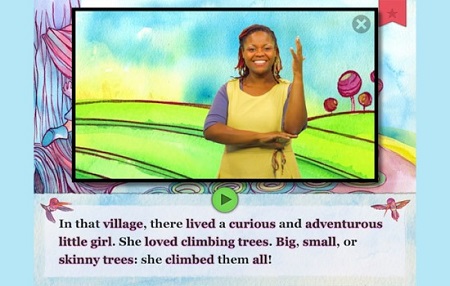A team from the Center for Access Technology at Rochester Institute of Technology's National Technical Institute for the Deaf has worked on a storybook app for deaf and hard-of-hearing children.
“The Baobab” is the first of a series of American Sign Language/English bilingual storybook applications for iPads and Android tablets. Developed by an all-deaf team as part of Visual Language & Visual Learning (VL2), a program funded by the National Science Foundation and managed by Gallaudet University in Washington, D.C., it is a children’s story about a curious girl who goes on an adventure. Parents may read the story to their young children, or together they can watch the story as told by a professional deaf storyteller.

Storyboook app helps deaf children learn language.
Children can learn vocabulary through the 170-word index highlighted within the story. When those words are tapped, videos show the word being signed and fingerspelled.
NTID’s CAT Lab was asked to help port the app, images and videos onto technology that could include watching the books on Android tablets. NTID faculty members Gary Behm and Brian Trager headed that project with assistance from RIT/NTID students Kelley Duran, who received her master’s degree in software engineering in December, and Chris Santoro, an information technology major from Holbrook, N.Y.
The app will be demonstrated at the Imagine RIT: Innovation and Creativity Festival on May 3. Visitors to the exhibit in the Gordon Field House can view and follow the story on iPads and Android tablets. The app can be downloaded for $4.99 on iTunes.
The application helps parents read to deaf children who rely more on visual cues. Studies on bilingualism and visual learning show that learning two languages leads to greater literacy skills in both languages, and the younger the child, the better.
“Learning bilingually is not limited to text," Behm said. "This app includes ASL storytelling, and this can benefit anyone, not just deaf children.”
“This is the first storybook app that is designed based on research for deaf children, which adds a valuable resource to existing storybook apps for all children in general,” said Melissa Malzkuhn, digital innovation and media strategies manager for VL2. “A majority of apps designed for kids are heavily sound based, so deaf children miss out on the different learning opportunities. So, our natural inclination in designing this is to approach it visually, starting with ASL storytelling. After all, deaf children are our future generations of leaders, innovators and creatives.”
Parents can also learn from the app. Most deaf children have hearing parents who often are new to sign language and visual learning.
“This storybook app is a fantastic resource, not just for the child to learn sign language, but also for the parent to learn sign language,” Malzkuhn said. “It creates an opportunity for parents to connect with their child through ASL.”
Source: https://www.ntid.rit.edu/news/storybook-app-helps-deaf-children-learn-language

